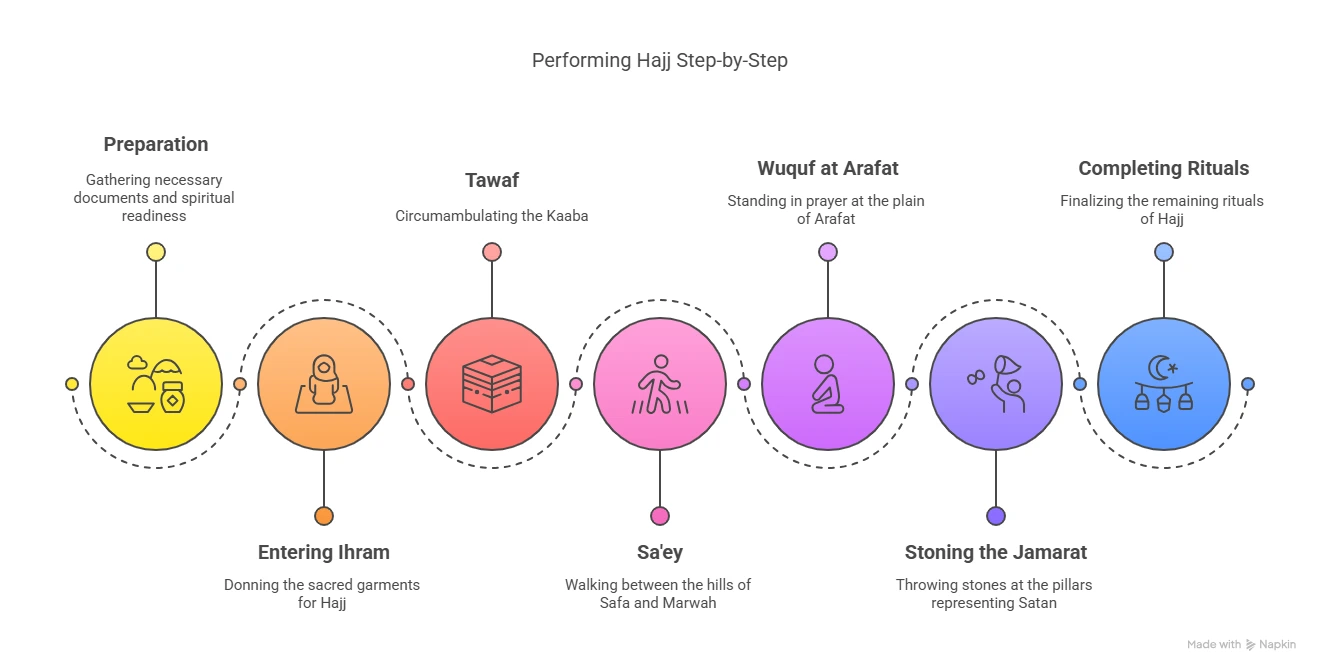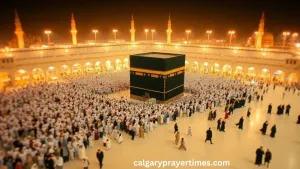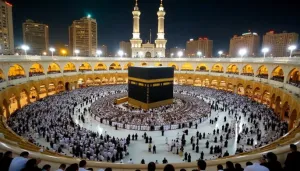How to Perform Hajj Step-by-Step
How to Perform Hajj Step-by-Step because Hajj is a sacred pilgrimage for Muslims, performed annually in Mecca, Saudi Arabia, typically from the 8th to 12th of Dhul-Hijjah. The most common form, Tamattu’, involves Umrah followed by Hajj, with key rituals including Tawaf, Sa’ey, Wuquf at Arafat, and stoning the Jamarat. Preparation includes obtaining a Hajj visa, spiritual readiness, and understanding the rituals, with specific rules for women traveling with a mahram.
The process is complex, and research suggests following detailed guides for a fulfilling experience, with variations depending on the type of Hajj chosen.
Visa and Travel Requirements
Pilgrims need a Hajj visa, obtainable through authorized operators or directly from Saudi authorities. For North American Muslims, the visa is restricted to those who have not performed Hajj in the last five years, requiring a passport, application, marriage/birth certificates, and immunization records Women must travel with a mahram (e.g., husband, father, brother) unless they are over 45 and in a group with the husband’s notarized consent ([wikiHow](https://www.wikihow.com/Perform-Hajj)). Arrival at King Abdulaziz International Airport in Jeddah is typically by the 4th of Dhul-Hijjah.
Preparing for the Journey
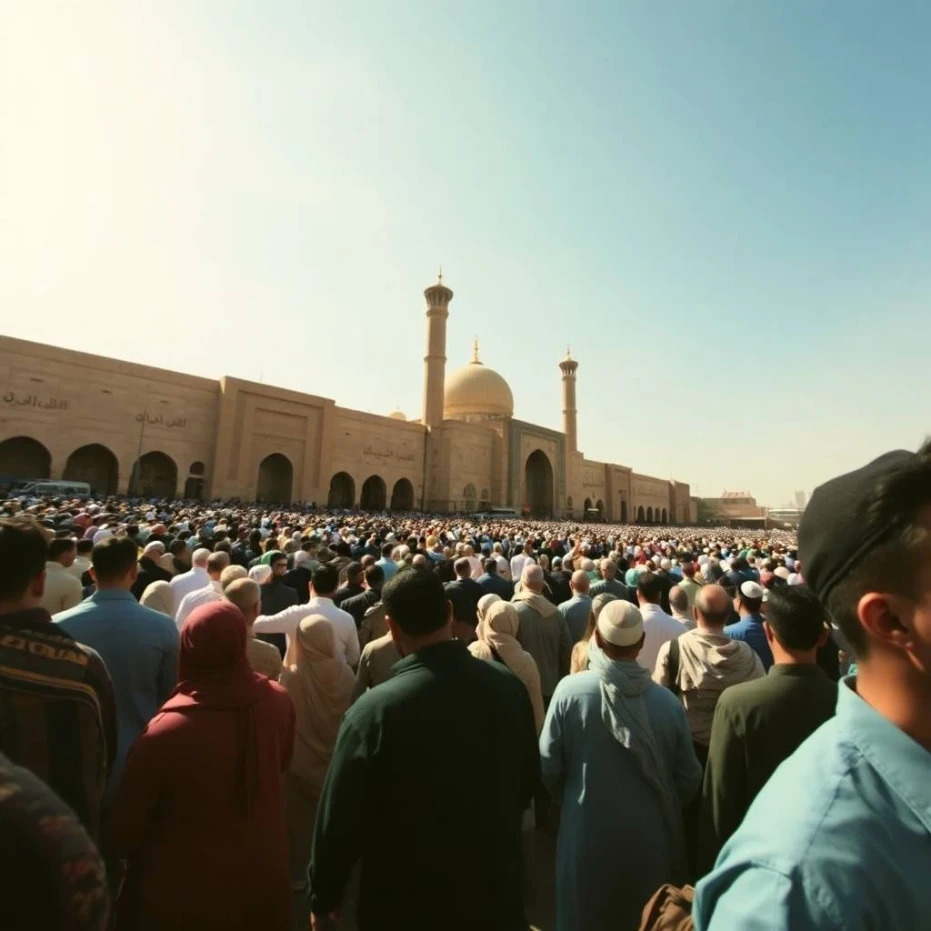
Before traveling, ensure you:
Understand the three types of Hajj: Tamattu’, Qiran (Umrah and Hajj continuous), and Ifraad (Hajj only). Tamattu’ is recommended by Prophet Muhammad (PBUH).
Obtain a Hajj visa, requiring a passport, application, and immunization records. For North American Muslims, you must not have performed Hajj in the last five years.
Women need a mahram (close male relative) unless over 45 and traveling in a group with husband’s consent
Spiritually prepare by studying rituals, repenting for sins, and focusing on sincerity for Allah.
Background and Significance of Hajj
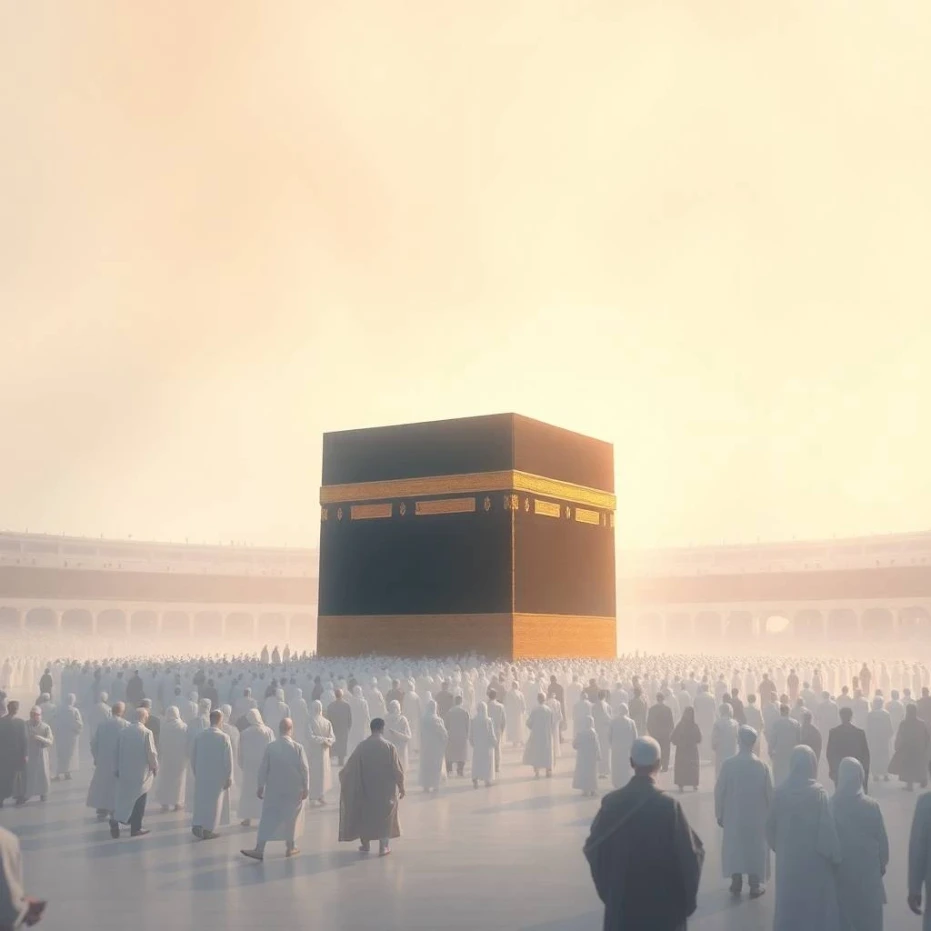
Hajj is one of the five pillars of Islam, a mandatory religious duty for every Muslim who is physically and financially able, to be performed at least once in their lifetime. It occurs annually in Mecca, Saudi Arabia, during the Islamic month of Dhul-Hijjah, typically from the 8th to the 12th day, though some rituals may extend to the 13th. The pilgrimage follows the footsteps of Prophet Abraham (Ibrahim) and his family, symbolizing unity, equality, and devotion to Allah. It is a profound spiritual journey, with historical roots tracing back to the construction of the Ka’bah by Abraham and Ishmael, as noted in Islamic tradition
The annual participation varies, with 2-3 million pilgrims typically attending, though numbers were reduced to 58,700 in 2021 due to the pandemic and 1 million last year, according to recent reports. This year, in 2025, Hajj is expected to draw significant numbers, aligning with the lunar calendar’s shift.
A Detailed Explanation to Performing Hajj
The journey involves several key rituals, detailed below for Tamattu:
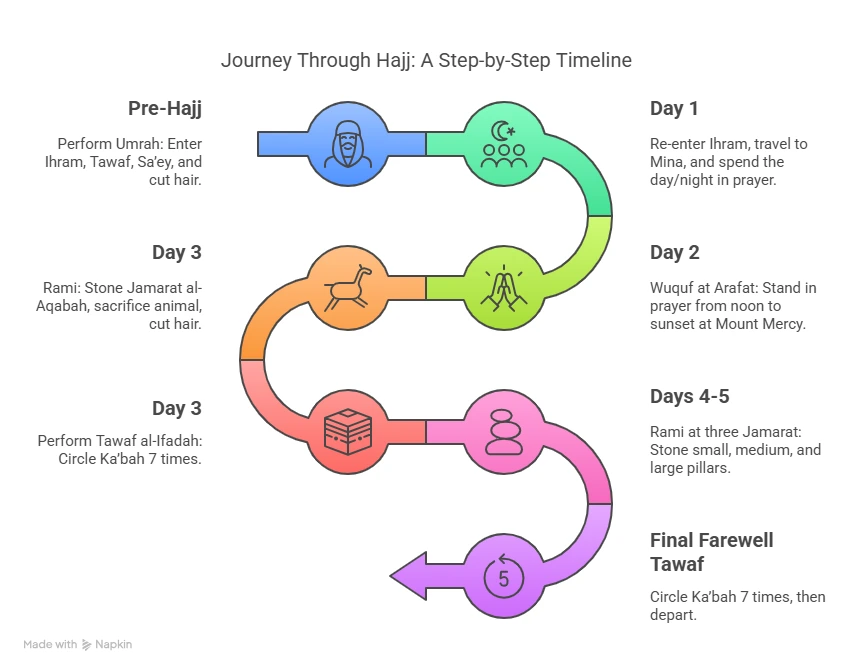
1. Performing Umrah (Before Hajj)
Enter Ihram at Miqat (boundary of Mecca), wearing plain garments (two sheets for men, modest clothing for women), and recite Talbiyah.
Perform Tawaf: Circle the Ka’bah seven times counter-clockwise, starting at the Black Stone.
Do Sa’ey: Walk seven times between Safa and Marwah, commemorating Hagar’s search for water.
Cut hair: Men shave or trim short, and women cut a lock, ending Umrah.
2. Day 1 (8th Dhul-Hijjah): Travel to Mina
Re-enter Ihram, travel to Mina (8 km from Mecca), and spend the day/night in prayer.
3. Day 2 (9th Dhul-Hijjah): Wuquf at Arafat
Travel to Arafat (15 km from Mina) by noon and stand in prayer from noon to sunset (Wuquf), a key day for forgiveness.
Move to Muzdalifah (11 km) at night, pray, sleep under the stars, and collect 49 pebbles.
4. Day 3 (10th Dhul-Hijjah): Rami, Sacrifice, Hair Cutting
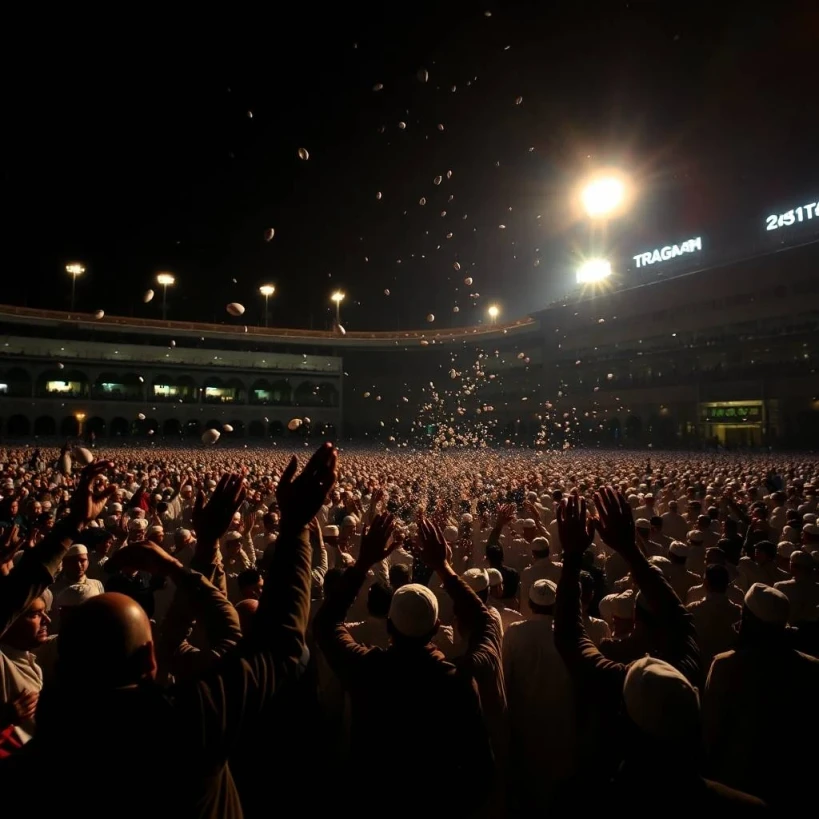
Return to Mina, stone Jamarat al-Aqabah with seven pebbles, sacrifice an animal (buy a voucher if needed), and cut hair (men shave, women trim).
5. Tawaf al-Ifadah and Sa’ey
Perform Tawaf al-Ifadah in Mecca (seven circles around Ka’bah); no additional Sa’ey is needed if done during Umrah.
6. Days 4-5 (11th-12th Dhul-Hijjah): Stoning the Three Jamarat
Stone all three Jamarat (small, middle, and large) with seven pebbles each day, continuing until sunset on the 12th (or 13th if needed).
7. Farewell Tawaf
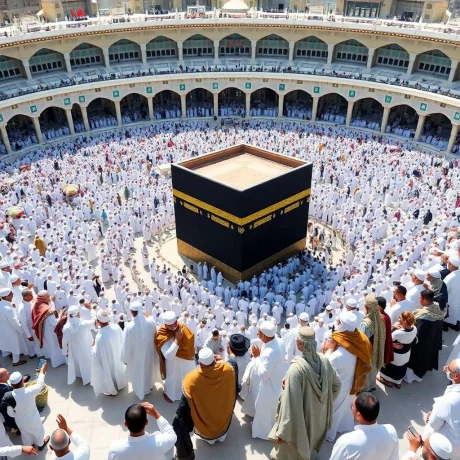
Before leaving, perform Farewell Tawaf (seven circles), marking the end of Hajj. Many visit Medina afterward, though it’s not part of Hajj.
Additional Tips
Enter holy sites with your right foot first, saying “Bismillah.”
Follow Ihram rules strictly (no smoking, arguing, cutting nails/hair, etc.).
Mistakes may require fidyah (penalty, e.g., animal sacrifice).
Non-Muslims cannot perform Hajj or enter Mecca’s holy areas.
Types of Hajj
There are three forms of Hajj, each with distinct rituals:
Tamattu:
It involves performing Umrah first, followed by Hajj, with a break in between. It requires a sacrificial animal and is the most common, encouraged by Prophet Muhammad (PBUH).
Qiran:
Combines Umrah and Hajj without exiting Ihram, also requiring sacrifice.
Ifraad:
Focuses on Hajj only, without Umrah, and no sacrifice is mandatory.
For this guide, we focus on Tamattu, as it is widely practiced and includes both Umrah and Hajj, providing a comprehensive experience. Preparation is crucial, involving both practical and spiritual aspects:
Spiritual Preparation
Pilgrims are advised to study the rituals, clear their minds of distractions, and repent for past sins, as Hajj is seen as a cleansing journey. The intention (niyyah) must be pure, performed solely for Allah, without seeking worldly gain or recognition.
Performing Umrah in Detail
For Tamattu, Umrah is performed first
Entering Ihram:
At Miqat, pilgrims bathe, wear Ihram garments, and recite Talbiyah: “Labbayk Allahumma labbayk. Labbayka la sharika laka labbayk. Innal hamda wan ni’mata laka wal mulk la sharika lak” (Here I am, O Allah, here I am). Men wear two unstitched sheets, and women wear modest clothing, avoiding scents.
Tawaf:
Circle the Ka’bah seven times counterclockwise, starting at the Black Stone, saying “Allahu Akbar” each pass. Men uncover the right shoulder (Iztiba’).
Sa’ey:
Walk seven times between Safa and Marwah, jogging between green lights for men, reciting Niyyah at Safa:
“Allahumma inni uridu l-sa’ya bayna al-safa wa l-marwata sab’ata ashwatin lillahi ta’ala fayassirhu li wa taqabbalhu minni.”
Hair Cutting:
Men shave or cut hair short, and women trim a lock, ending Umrah.
On the 9th, travel to Arafat for Wuquf, standing from noon to sunset, a pivotal moment for forgiveness. After sunset, move to Muzdalifah, pray, and collect pebbles.
Additional Etiquette and Tips
Enter holy sites with the right foot first, saying “Bismillah.”
Maintain Ihram rules strictly—no cologne, perfume, makeup, smoking, swearing, shaving, cutting nails, or sexual activity.
Mistakes (e.g., breaching Ihram) may require fidyah, such as animal slaughter. Consult a scholar if unsure.
Non-Muslims cannot perform Hajj, and it is illegal for them to enter Mecca’s holy parts.
Frequently Asked Questions (FAQs)
Conclusion
Hajj is a transformative journey, uniting Muslims globally in worship and reflection. By following this detailed guide, pilgrims can navigate the complexities of Tamattu’ Hajj, ensuring a fulfilling experience. The rituals, from Tawaf to Wuquf, embody faith, humility, and community, leaving pilgrims with renewed spiritual purpose.

